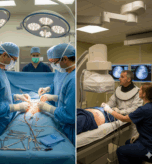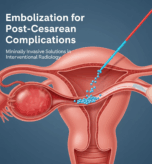Are you suffering from chronic knee pain due to osteoarthritis? Have traditional treatments failed to provide lasting relief? You’re not alone. Over 365 million people globally suffer from knee osteoarthritis (OA), and many are searching for alternatives to major surgery.
Enter Geniculate Artery Embolization (GAE) – a groundbreaking, minimally invasive procedure that’s changing the landscape of knee pain management in 2025.
What is Geniculate Artery Embolization (GAE)?
Geniculate Artery Embolization is a cutting-edge interventional radiology procedure. It treats knee osteoarthritis pain without major surgery. This innovative technique targets the root cause of pain by addressing abnormal blood vessel growth in the knee joint.
How Does GAE Work?
The procedure involves:
- Selective catheterization of genicular arteries supplying the knee joint
- Identification of abnormal hypervascular tissue causing inflammation
- Precise embolization using tiny microspheres (100-300 micrometers)
- Reduction of synovial inflammation and pain signals
Unlike traditional treatments that only mask symptoms, GAE addresses the underlying pathophysiology of osteoarthritis pain.
The Science Behind GAE: Why It Works
Recent research published in 2025 has shed light on the mechanism of action:
1. Targets Neovascularization
Osteoarthritis triggers the growth of abnormal blood vessels in the synovial lining. These vessels are accompanied by nerve fibers that transmit pain signals.
2. Reduces Inflammation
By blocking blood flow to hypervascular synovial tissue, GAE significantly reduces local inflammation.
3. Interrupts Pain Pathways
The procedure disrupts the neoinnervation (new nerve growth) associated with abnormal blood vessels. This provides lasting pain relief.
4. Preserves Joint Structure
Unlike surgery, GAE doesn’t alter the joint anatomy. Therefore, it’s an ideal bridge therapy.
Clinical Evidence: What the Latest Studies Show
The effectiveness of GAE is backed by robust clinical evidence from 2025:
2-Year Follow-Up Data (GENESIS Trial & Meta-Analyses)
- 78% of patients achieved significant pain reduction
- 92% met clinical improvement criteria (MCID)
- Sustained relief documented up to 24 months
- 99.7% technical success rate
- Minimal side effects – most common being temporary skin discoloration (11.6%)
Key Findings from Recent Studies
Pain Reduction:
- Mean Visual Analog Scale (VAS) improved from 58.6 at baseline to 37.7 at 2 years
- Patients with higher baseline pain showed greater improvement
Functional Improvement:
- Significant improvements in KOOS (Knee Injury and Osteoarthritis Outcome Score)
- Reduced analgesic medication usage
- Enhanced quality of life scores
Safety Profile:
- No cases of osteonecrosis reported
- Self-limiting side effects only
- Does not complicate future knee surgery if needed
Who is an Ideal Candidate for GAE?
GAE is particularly beneficial for patients who:
✅ Have mild to moderate knee osteoarthritis (Kellgren-Lawrence Grade 1-3)
✅ Are 45 years or older with chronic knee pain (>6 months)
✅ Have failed conservative treatments including:
- Physical therapy
- Weight management
- NSAIDs and pain medications
- Intra-articular injections (corticosteroids, hyaluronic acid)
✅ Are not ready for knee replacement surgery
✅ Have medical conditions that make surgery high-risk
✅ Want to avoid major surgery and its associated risks
Exclusion Criteria
❌ Severe osteoarthritis (KL Grade 4)
❌ Rheumatoid or infectious arthritis
❌ Previous knee arthroplasty
❌ Severe renal impairment (eGFR <45)
❌ Irreversible coagulopathy
The GAE Procedure: What to Expect
Before the Procedure
- Comprehensive evaluation including X-rays and MRI
- Assessment by interventional radiologist
- Review of medical history and medications
- Pre-procedure instructions (fasting, medication adjustments)
During the Procedure
- Duration: 1-2 hours
- Anesthesia: Local anesthesia with conscious sedation
- Access: Small puncture in the groin (femoral artery)
- Imaging: Real-time fluoroscopy and cone-beam CT guidance
- Embolization: Targeted delivery of microspheres to abnormal vessels
- Monitoring: Continuous vital signs monitoring
After the Procedure
- Observation: 4 hours in recovery
- Discharge: Same-day discharge in most cases
- Pain Management: Mild discomfort managed with over-the-counter medications
- Activity: Gradual return to normal activities within days
- Follow-up: Scheduled at 6 weeks, 3 months, 1 year, and 2 years
Advantages of GAE Over Traditional Treatments
| Feature | GAE | Knee Replacement | Conservative Treatment |
|---|---|---|---|
| Invasiveness | Minimal (small puncture) | Major surgery | Non-invasive |
| Recovery Time | Days | Months | N/A |
| Hospital Stay | Same-day discharge | 2-4 days | N/A |
| Anesthesia | Local | General | None |
| Pain Relief Duration | 2+ years | 15-20 years | Temporary |
| Complication Risk | Very low | Moderate | Low |
| Effectiveness | 78% success | 80-90% success | Variable |
Why Choose GAE?
🔹 Minimally Invasive
No large incisions, no implants, no general anesthesia required.
🔹 Quick Recovery
Most patients return home the same day. Additionally, they resume normal activities within days.
🔹 Long-Lasting Relief
Clinical studies show sustained pain reduction for 2+ years.
🔹 Safe & Effective
99.7% technical success rate with minimal complications.
🔹 Preserves Future Options
Does not preclude knee replacement surgery if needed later.
🔹 Natural Healing
Works with your body’s natural processes without foreign implants.
Potential Side Effects and Complications
GAE has an excellent safety profile. The most common side effects include:
Minor Side Effects (Self-Limiting)
- Temporary skin discoloration (11.6%)
- Mild bruising at puncture site
- Transient knee discomfort
- Minor groin hematoma
Rare Complications
- Deep vein thrombosis (due to immobilization)
- Allergic reaction to contrast material
- Non-target embolization (prevented with advanced imaging)
Important Note: No cases of osteonecrosis or major complications have been reported in recent trials.
GAE vs. Other Knee OA Treatments: A Comparison
1. GAE vs. Intra-Articular Injections
- Duration: GAE provides relief for 2+ years vs. 3-6 months for injections
- Mechanism: GAE addresses root cause vs. temporary symptom relief
- Frequency: One-time procedure vs. repeated injections
2. GAE vs. Total Knee Arthroplasty (TKA)
- Invasiveness: Minimal vs. major surgery
- Recovery: Days vs. months
- Ideal for: Mild-moderate OA vs. severe OA
- Reversibility: Doesn’t alter anatomy vs. permanent joint replacement
3. GAE vs. Physical Therapy
- Effectiveness: 78% success rate vs. variable results
- Duration: Long-lasting vs. requires ongoing commitment
- Best Use: Complementary approaches for optimal outcomes
The Future of GAE: Ongoing Research
Several clinical trials are currently underway to further establish GAE’s role:
GRAVITY Trial (Expected 2027):
Comparing GAE vs. conservative management for moderate-to-severe knee OA.
GENESIS II Trial:
Double-blind randomized sham-controlled trial in the UK.
MOTION Trial:
International multicenter study comparing GAE vs. intra-articular corticosteroid injection.
These studies will provide additional insights into optimal patient selection criteria and long-term outcomes beyond 2 years.
Frequently Asked Questions (FAQs)
Q1: Is GAE painful?
No. The procedure is performed under local anesthesia with conscious sedation. Most patients experience minimal discomfort during and after the procedure.
Q2: How long does the procedure take?
The GAE procedure typically takes 1-2 hours, including preparation and recovery time.
Q3: When will I see results?
Most patients notice improvement within 2-6 weeks. However, continued improvement occurs over 3 months.
Q4: Can GAE be repeated if pain returns?
Yes. GAE can be safely repeated if symptoms recur. Studies show 8.3% of patients undergo repeat GAE over 2 years.
Q5: Will GAE affect future knee replacement surgery?
No. Studies confirm that GAE does not complicate future knee arthroplasty if needed.
Q6: What is the success rate of GAE?
Clinical studies report 78% of patients achieve significant pain reduction. Moreover, 92% meet clinical improvement criteria.
Q7: Are there any activity restrictions after GAE?
Minimal restrictions apply. Most patients resume normal activities within days. Additionally, gradual return to exercise is recommended.
Q8: Is GAE covered by insurance?
Coverage varies by insurance provider. However, many are beginning to cover GAE as evidence grows. Check with your provider.
Q9: How does GAE compare to stem cell therapy?
GAE has more robust clinical evidence with FDA-approved embolic agents. In contrast, stem cell therapy remains largely experimental.
Q10: Can both knees be treated at once?
Typically, one knee is treated at a time. Subsequently, the second knee can be treated after recovery if needed.
Why Choose Dr. Vrishit Saraswat for GAE?
Dr. Vrishit Saraswat is a leading interventional radiologist specializing in minimally invasive procedures for pain management. With extensive experience in GAE, Dr. Saraswat offers:
✅ Expertise: Advanced training in interventional radiology
✅ Precision: State-of-the-art imaging technology (cone-beam CT, fluoroscopy)
✅ Patient-Centered Care: Comprehensive evaluation and personalized treatment plans
✅ Proven Results: High success rates with patient satisfaction
✅ Ongoing Support: Long-term follow-up and care
Take the First Step Towards Pain-Free Living
Don’t let knee pain control your life any longer. Geniculate Artery Embolization offers a safe, effective, and minimally invasive solution for chronic knee osteoarthritis.
Schedule Your Consultation Today:
Conclusion
Geniculate Artery Embolization represents a paradigm shift in the management of knee osteoarthritis. With strong clinical evidence, minimal invasiveness, and long-lasting results, GAE fills a critical gap between conservative treatments and major surgery.
As we move through 2025, GAE is poised to become a standard treatment option for patients with mild to moderate knee OA who seek effective pain relief without the risks and recovery time of surgery.
If you’re suffering from chronic knee pain, GAE might be the solution you’ve been searching for. Therefore, take the first step today.






